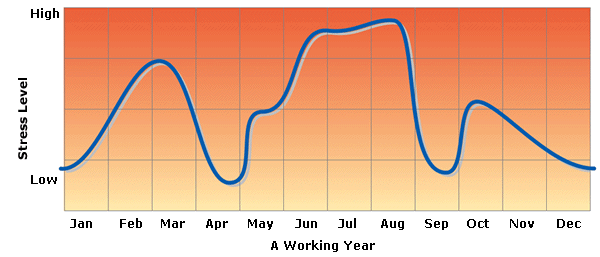Stress can be insidious and cumulative. The best way to avoid
suffering from it is to learn to anticipate it. By analyzing and pinpointing
events and times that regularly cause stress, it is possible to set about
preventing further problems from occurring.
Recognizing stressful times
In the aftermath of a stressful time at work, it is easy to forget
just how you managed to cope. In order to analyze stress effectively and make
changes, you need to recognize your own patterns and cycles of behaviour. To do
this, familiarize yourself with those times of year, month, week, and day when
you find you are most busy, keep records of the problems you experience, and
obtain feedback from colleagues on how you perform when stressed.
Annual work patterns
Make up an annual or half-yearly chart to help you analyze annual
work patterns. List all the major projects or tasks you need to complete, along
with their start and end dates. Draw a line between these two dates for each
task, and you will be able to see where the overlaps occur. These mark your
busiest times at work and will help you to plan ahead, avoiding any
bottlenecks, and taking holidays to coincide with quiet periods.
Preparing for pressure
The half-yearly chart discussed here shows the work pattern of
someone whose busiest period is in March. During this time, five major
tasks are ending, just
beginning, or are in working progress.

Daily work patterns
Difficulties in time management and workload prioritization are
among the most common causes of stress. Once you have identified where such
problems exist, you will be better able to handle them. The best way to do this
is to keep a detailed daily stress diary. Prepare a “to do” list
of all the tasks you have to perform each day, and use this to analyze how you
are coping with your workload. Note down any problems that interfered with or
prevented you from completing your tasks. This may take time to produce, but in
the long term will prevent day-to-day stress.
Using a stress diary
The three main reasons for using a stress diary are: to record and
pinpoint stressful areas; to highlight increases in workload or other
potentially stressful developments as they arise; and to have a tool for
assigning priorities. Set out your stress diary as shown here, or tailor it to
your preferences.

Getting feedback
A crucial part of dealing with stress is being able to communicate
effectively with the people you spend so much time with – your
colleagues. One way of doing this is to ask colleagues for help and advice in
response to stressful situations.
If you find yourself under stress, try to make contact with
colleagues who are sympathetic and attentive listeners – those who can
resist the temptation to interrupt. Even if they are not in a position to offer
advice, they can still help by letting you talk through your problems and
giving you support and encouragement. Ask for honest feedback about when you
appear to be most stressed – do you cope with meetings calmly but appear
stressed before a presentation, for example? In return, try to offer support
when they are under pressure. Be an attentive listener, and encourage them to
talk openly about problems.
Gaining confidants
Sharing information bonds people, both in and out of the
workplace. You may find that a colleague has a solution to a problem you have
been having.

Analyzing stress cycles
Once you have analyzed your busy times of the year and recorded your
daily workload for a month or so, take an overview to determine your personal
daily, monthly, and yearly stress cycles. Bear in mind that the effects of
cumulative pressure can increase stress. What may be easy to cope with during a
quiet period will feel less possible during a crisis.
Consider which tasks you find particularly stressful – doing
a large number of routine tasks may be less stressful than completing an
urgent, complex one. Make yearly and daily charts of stress cycles, and use
them to help you plan for a regulated stress pattern in the future.
A yearly cycle
The effects of long-term stress can be serious. The person to
whom the chart belongs spends more than five months of the year trying
to cope with
high level of stress. Periods of low stress occur only when
on holiday or
spending time away from the office.

A daily cycle
Although every day is different, a typical pattern usually emerges
for most people. Consider whether you can alleviate stress, for example, by
delegating more or eliminating unncessary tasks.

TIP
Ask a colleague to let you know when you appear to be
stressed.
TIP
Overestimate when calculating the time that a project will
take.
TIP
Jot down problems on a day-to-day basis, and see if a pattern
emerges.
TIP
Set realistic goals so that you do not feel stressed by too many
failures to meet deadlines.
TIP
Never knowingly embarrass people by asking for help they cannot
give.
TIP
Keep negative opinions about your colleagues to yourself.